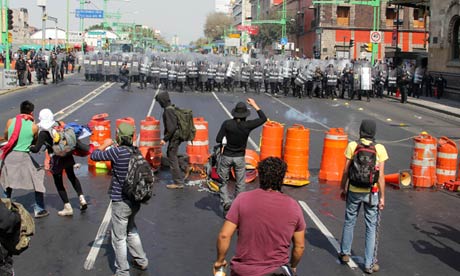Mexican police brutality uncovered by human rights investigators
 Protests in Mexico City during the inauguration of President Enrique Peña Nieto. Photograph: LatinContent /Getty Images
Protests in Mexico City during the inauguration of President Enrique Peña Nieto. Photograph: LatinContent /Getty Images
Read by 1,063 people
Thursday 6 December 2012Four case of torture among alleged offences during inauguration of President Enrique Peña Nieto
A preliminary investigation by Mexico City's human rights commission has found evidence of police brutality and arbitrary detentions during the violent protests during last Saturday's inauguration of President Enrique Peña Nieto.
The ongoing investigation has identified at least four cases of possible torture, three of them involving electric shocks, as well as 22 cases of unjustified arrests among the 70 people still in jail in relation to the protests. Many of these face a preliminary charge of "attacks against the public peace", which carries a long prison term.
"The important thing here is that the authorities provide convincing evidence that the people who are sanctioned were really involved in the events and that we don't see people criminalised who were protesting peacefully or, in some cases, not even participating in the protests," the head of the commission, Luis González Placencia, told MVS Noticias.
The day began with intense clashes between masked youths and federal police around 10ft high barricades set up to keep protesters away from the inauguration ceremony in the congressional chamber. These events left one protestor in a coma and another without the sight in one eye.
Further clashes with city police broke out later on the outskirts of the city centre, while roving gangs smashed up businesses in the area. These events coincided with the arrest of around 100 people by local police, though around 30 of these released within hours.
There were also non-violent protests, and the commission's investigation partially supports the claims of activists and relatives of some of those in jail who insist the police went after the wrong people, including two Romanian freelance journalists.
The investigation drew from the testimony of those arrested as well as videos and photographs that have been widely circulated on social and mainstream media.
In one video, a man in a mauve shirt is seen standing in front of riot police verbally demanding that they release detainees not in the picture. An officer comes up from behind to pick him up and carry him behind police lines.
Placencia said the case was "emblematic" of a trend in police strategies in which "they encapsulate a person, take them away, and then try to justify some kind of link with criminal activities".
The city human rights commission's investigation does not include allegations of excessive use of force levelled at the federal police, or the claims that it used plainclothes provocateurs.
The federal authorities have denied charges that police used rubber bullets. The city authorities have said people in civilian clothes photographed behind federal police lines were actually contracted workers called in to chain the barricades together.
No comments:
Post a Comment